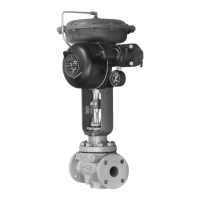Instruction Manual
D200108X012
546 Transducer
March 2015
6
If specified, the filter regulator is mounted on the transducer case. A pressure gauge on the regulator shows the supply
pressure to the transducer.
1. Connect a supply pressure source to the 1/4 NPT IN connection on the filter regulator (if furnished) or to the 1/4
NPT SUPPLY connection on the transducer case (if a regulator is not furnished).
2. Run 9.5 mm (3/8‐inch) outside diameter tubing from the 1/4 NPT OUTPUT connection on the transducer case to
the input connection on the pneumatic actuator or valve positioner. This connection is made at the factory if the
unit is shipped mounted on an actuator as shown in figure 1.
Diagnostic Connections
To support diagnostic testing of valve/actuator/positioner packages, special connectors and hardware are available.
Typical connector installations are shown in figure 3. The hardware used includes a 1/4 NPT pipe nipple and pipe tee
with a 1/8 NPT pipe bushing for the connector. The connector consists of 1/8 NPT body and body protector.
Note
If the transducer is used in a valve assembly with a positioner, no connections for diagnostic testing are required for the
transducer. Install the connections for diagnostic testing at the positioner.
Figure 3. Diagnostic Connections
PIPE NIPPLE (OUTPUT CONN)
12B8041‐B
A6072‐1 / IL
PIPE TEE
PIPE
BUSHING
BODY
BODY
PROTECTOR
SUPPLY
GAUGE
STEM PROVIDED
WHEN GAUGE
IS SPECIFIED
Install the connectors and hardware between the transducer and the actuator.
1. Before assembling the pipe nipple, pipe tee, pipe bushings, actuator piping, and connector body, apply sealant to
all threads.
2. Turn the pipe tee to position the connector body and body protector for easy access when doing diagnostic testing.
Electrical Connections
WARNING
For explosion‐proof applications, disconnect power before removing the transducer cover. Personal injury or property
damage may result from fire or explosion if power is applied to the transducer with the cover removed in a hazardous area.
Also refer to the Warning at the beginning of the Operating Information section.

